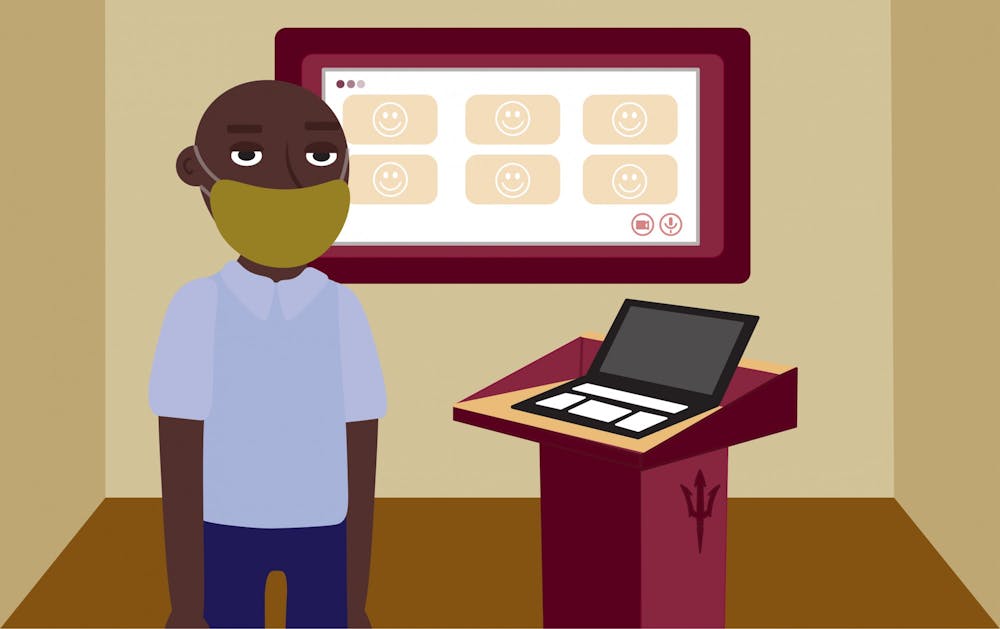As the Aug. 20 start day for ASU’s fall semester draws near, the biggest concern faculty have about returning has nothing to do with academics, but what they will do when students have problems that extend beyond the classroom due to the coronavirus.
Students and faculty getting sick isn’t a matter of if, it is a matter of when, multiple faculty members said.
"I think it’s horrifying," said Rikki Tremblay, a communication instructor at the Hugh Downs School of Human Communication, about the return to campus this fall.
According to the Arizona Department of Health Services, the state has over 180,000 total confirmed cases of the coronavirus and 3,932 deaths. After a rapid period of growth in cases in June, Arizona is now seeing a slight decline in cases, according to data from John Hopkins University Coronavirus Resource Center.
But faculty worry that the return of thousands of people to ASU’s campuses could result in a spike of cases within the community.
"The University can do everything it wants about providing free masks, free testing and coming up with good guidance on how to conduct classroom experiences," said Evan Berry, an assistant professor of environmental humanities in the School of History, Philosophy, and Religious Studies. "But dorms and off-campus activities are really hard to control and those are the most likely sites of transmission."
Professors' fears of returning are warranted. ASU's four main campuses all reside within Maricopa county, where two-thirds of COVID-19 cases in Arizona have been found, according to ADHS. Data from ADHS also shows that people between the ages of 20-44 make up just under half of the total coronavirus cases in the state, with health officials citing younger people as part of the reason cases rose over the summer.
"For the last five months, I tried really hard both for myself and for others to follow these guidelines to not spread the virus," said David Boyles, an instructor at the writing program in the English department. "Now, I might be going back to campus exposing myself and others."
Every faculty member who spoke to The State Press hopes the semester goes well, but they said the pandemic has shown that wishful thinking won't make the coronavirus go away.
"The more we deny the reality of the situation, the longer we drag this on," Boyles said.
Faculty were left out University’s decision-making process
ASU President Michael Crow announced in a statement July 27 that the University would continue with its fall semester plans to allow faculty and students to return to campus with guidelines in place to enable a safe return.
But instructors feel the discussions regarding the decision to return excluded those who it affects most: faculty and students.
“We were basically told to sit back and wait,” said Amira de la Garza, an associate professor at the Hugh Downs School of Human Communication.
Like students, many faculty members felt left out in the decision-making process by the University. Communication regarding protocols for faculty varied from school to school. Some faculty members received frequent communication from their deans and were able to have questions answered, others felt lost.
“It really feels like faculty had no voice in this,” said a communications instructor who was granted anonymity because they are a non-tenured faculty member who feared for their job. “The assumption was if we work with technology, follow the guidelines, have Plexiglas, hand sanitizer and clean the classrooms twice a day, faculty will be willing to return.
"I think that was a poor assumption to make that we are willing to immerse ourselves into this dangerous environment.”
READ MORE: COVID-19 and ASU: Here's what you need to know
An ASU lecturer, who was granted anonymity for fear of losing their job, questioned the University's lack of transparency, pondering whether the University was making decisions based on health or based on "the bottom line."
De la Garza and Berry both said they think pressure from the government aided in the push for the University to return this fall. De la Garza and others said that considering the University is filled with award-winning faculty and experts on a variety of topics, their thoughts should have been considered when they were drafting plans.
A University spokesperson said the government in no way pressured the school to open.
The lecturer said they understand how difficult it is to make this decision considering the financial implication the University is facing. But after watching K-12 teachers tragically pass away this summer, they don’t want the ASU community "to be on a Zoom funeral for one of our own in a couple of months,” the lecturer said.
Some faculty going fully online, others adapting courses for any scenario
With the safety of teaching in person uncertain, ASU has allowed several faculty to teach remotely after going through an accommodations request process.
According to a University spokesperson, around 1,400 faculty requested accommodations for the fall semester, around 28% of ASU’s total full-time faculty. Deans are still in the process of approving the requests, the spokesperson said.
They added that “instructional assistants will be used, as will graduate teaching assistants” to assist classes without an in-person instructor, though “how many is still being determined.” For example, students will still be asked to come into the classroom while a teaching assistant assumes the presence of the in-person instructor.
However, Boyles and the lecturer said that due to their positions as non-tenured faculty, they felt they could not submit an accommodation request and must teach in person.
So far, the University has not had to lay-off or furlough workers, something that has been done at UA and NAU. But the lecturer worries contingent faculty will be the first to go if lay-offs become necessary due to the economic impact the coronavirus will have on the University.
Conducting their in-person courses may be the only way they avoid that, the lecturer said.
"There's a lot of faculty who don't want to make waves," Boyles said. "The way the accommodations were laid out, it made someone like me not want to submit one. But at the same time, I don't want to go back to campus."
Regardless of what modality of teaching faculty will use, many are confident they can continue to deliver a quality form of education remotely. After having prior experience teaching remotely, time to revise courses and University-held workshops to help faculty improve their use of technology while teaching, remote learning is not as daunting as it once was.
“It (the pandemic) really forces us to think about what the most essential components of our curriculum are,” said de la Garza, who will be teaching remotely due to health concerns.
Other faculty have been more supportive of ASU's plans. Natalie Welcome, a math instructor at the College of Integrative Sciences and Arts who has been approved to teach remotely, said the flexibility the University has provided faculty and students for the semester was the right decision.
“I’m excited that we are able to offer students options,” said Kermit Brown, an instructor at the College of Integrative Sciences and Arts, who is willing to return to the classroom. “I’m optimistic, but at the same time, I know there are going to be some growing pains and a learning curve.”
Nathan De'Shon Myers, an assistant professor of voice at The School of Music, will be teaching all of his private instruction singing and choir courses online. The private instruction sessions don't change much, but his choir classes have become more focused on lectures and on teaching students the fundamentals of performing, he said.
"The whole experience is centered around being in the same room and singing together," Myers said. "Doing it asynchronously presents some challenges."
With no end in sight for the pandemic, the key for a successful semester comes down to faculty being available for their students and quickly adjusting courses if and when necessary.
“My challenge to myself is to remember that this will be a teaching experience of accountability unlike any I’ve had in the 40 years I’ve been a teacher,” de la Garza said.
Brown said in this environment, it is inevitable that problems will emerge, but once “we get into our groove, it’s going to work out.”
A potential coronavirus hotspot: ASU campuses
While faculty are grateful for the University's help, some worry the safety guidelines in place for an in-person return is simply not enough.
“I’m going to be betting against the house every day I’m in the classroom,” the non-tenured lecturer said. “There will be protocols, there will be masks, but with the increasing evidence this virus is airborne, I am worried about getting sick.”
The lecturer added that their broader concern is with students who may live in multi-generational households who could end up bringing the virus home to someone who is more at risk.
In interviews with The Washington Post, health experts said young people are bringing the coronavirus home to older family members. According to 2018 data from the Pew Research Center, multi-generational families across the country have grown and young adults were the most likely to live in such homes.
“Immunity doesn't exist between classes, ethnicities and races,” the communications instructor said. “We’re forgetting that a huge population of our ASU faculty and staff are older individuals. So, I'm not entirely sure how smart it is to encourage all these young people to just go to college, instead of investing in online ways of learning.”
University officials have repeatedly told The State Press the school has spent millions of dollars on enhancing technology to prepare for the semester. The communications instructor acknowledged they are not an economics expert, but the University “can recover money.” Lives cannot be replaced, they said.
ASU faculty are far from alone in their worries. The Chronicle of Higher Education reported that faculty and staff at the University of North Carolina “are preparing a lawsuit to postpone the start of classes this fall.” Over the past few months, professors at universities across the country have penned editorials arguing that campuses should remain closed for the fall semester and returning would be detrimental to the health and well-being of students, staff and faculty.
But the blend of online and in-person classes benefits those who are often left behind. Students may not have reliable internet access, grades and course content suffer when solely on a screen and the traditional college experience would not exist.
But all of those things are minor fixes, the communications instructor said. Students, staff and faculty getting sick — on the other hand — are major ones.
Editor's Note: This story was updated on August 6 at 4:35 p.m. to include a statement from the University about the government's influence on reopening. The government did not encourage, nor pressure, the school to reopen, a spokesperson said.
Reach the reporter at wmyskow@asu.edu and follow @wmyskow on Twitter.
Like The State Press on Facebook and follow @statepress on Twitter.

Wyatt Myskow is the project manager at The State Press, where he oversees enterprise stories for the publication. He also works at The Arizona Republic, where he covers the cities of Peoria and Surprise.




